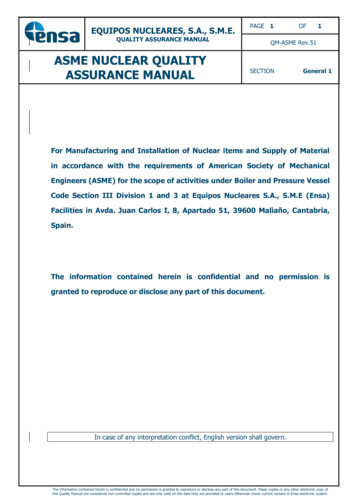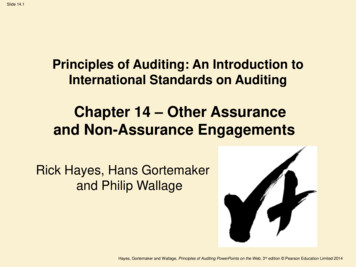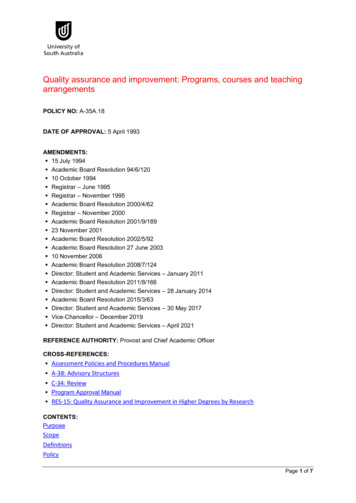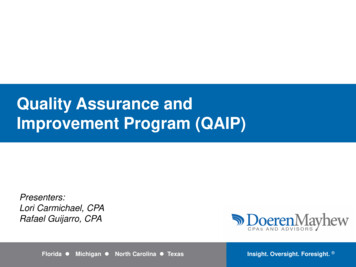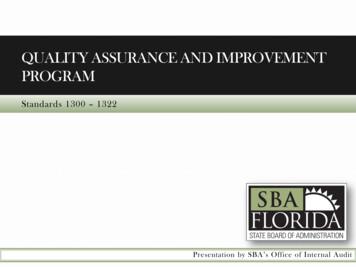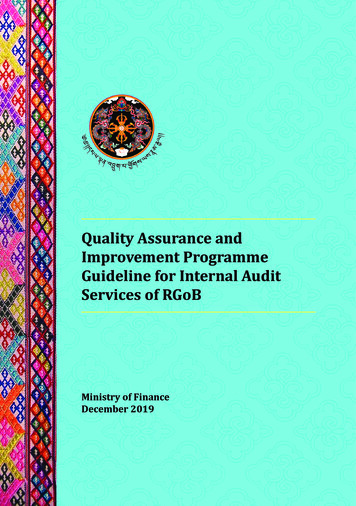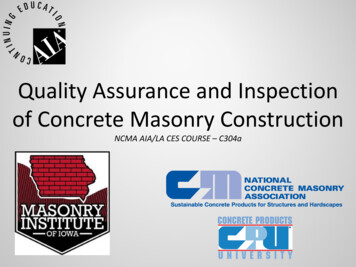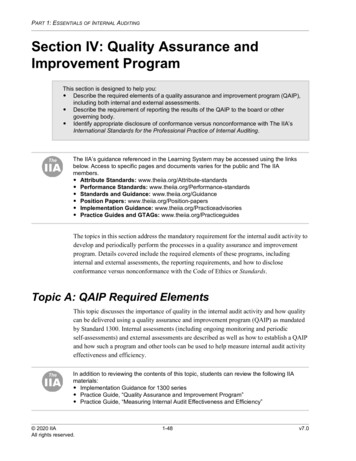
Transcription
PART 1: ESSENTIALS OF INTERNAL AUDITINGSection IV: Quality Assurance andImprovement ProgramThis section is designed to help you: Describe the required elements of a quality assurance and improvement program (QAIP),including both internal and external assessments. Describe the requirement of reporting the results of the QAIP to the board or othergoverning body. Identify appropriate disclosure of conformance versus nonconformance with The IIA’sInternational Standards for the Professional Practice of Internal Auditing.The IIA’s guidance referenced in the Learning System may be accessed using the linksbelow. Access to specific pages and documents varies for the public and The IIAmembers. Attribute Standards: www.theiia.org/Attribute-standards Performance Standards: www.theiia.org/Performance-standards Standards and Guidance: www.theiia.org/Guidance Position Papers: www.theiia.org/Position-papers Implementation Guidance: www.theiia.org/Practiceadvisories Practice Guides and GTAGs: www.theiia.org/PracticeguidesThe topics in this section address the mandatory requirement for the internal audit activity todevelop and periodically perform the processes in a quality assurance and improvementprogram. Details covered include the required elements of these programs, includinginternal and external assessments, the reporting requirements, and how to discloseconformance versus nonconformance with the Code of Ethics or Standards.Topic A: QAIP Required ElementsThis topic discusses the importance of quality in the internal audit activity and how qualitycan be delivered using a quality assurance and improvement program (QAIP) as mandatedby Standard 1300. Internal assessments (including ongoing monitoring and periodicself-assessments) and external assessments are described as well as how to establish a QAIPand how such a program and other tools can be used to help measure internal audit activityeffectiveness and efficiency.In addition to reviewing the contents of this topic, students can review the following IIAmaterials: Implementation Guidance for 1300 series Practice Guide, “Quality Assurance and Improvement Program” Practice Guide, “Measuring Internal Audit Effectiveness and Efficiency” 2020 IIAAll rights reserved.1-48v7.0
Section IV: Quality Assurance and Improvement ProgramQuality and the QAIPAttribute Standard 1300, “Quality Assurance and Improvement Program”The chief audit executive must develop and maintain a quality assurance andimprovement program that covers all aspects of the internal audit activity.Organizations undergo refinement, and internal processes change and evolve. As anorganization changes, auditing services must keep pace. To ensure its consistent relevanceand quality, the internal audit activity is required to have a quality assurance andimprovement program (QAIP) in place.The mandatory scope of a QAIP is limited to the mandatory elements of the IPPF. Thisincludes the Standards, the Code of Ethics, the Core Principles for the ProfessionalPractice of Internal Auditing, and the Definition of Internal Auditing. Assessors canevaluate against recommended guidance (implementation guidance and supplementalguidance) or make additional improvement recommendations, but these are notmandatory.Let’s break down the interpretation (shown in italics) and implementation guidance or otherIIA guidance (the sub-bullets) for Standard 1300: A quality assurance and improvement program is designed to enable an evaluation of theinternal audit activity’s conformance with the Definition of Internal Auditing and theStandards and an evaluation of whether internal auditors apply the Code of Ethics. (Theterm “conformance to the IPPF” is used in the rest of this topic to refer to conformanceto these and other mandatory elements of the IPPF.) A well-developed QAIP helps embed the concept of quality in the internal auditactivity and operations. Following a general methodology helps ensure quality and conformance to the IPPF. It is crucial that the CAE regularly reviews the IPPF and is aware of any changes thatmay need to be communicated throughout the internal audit activity. The program also assesses the efficiency and effectiveness of the internal audit activityand identifies opportunities for improvement. The QAIP needs to be periodically evaluated and updated to ensure that it adds value. A QAIP is a key way to measure the effectiveness and efficiency of the internal auditactivity. The chief audit executive should encourage board oversight in the quality assurance andimprovement program. 2020 IIAAll rights reserved.1-49v7.0
PART 1: ESSENTIALS OF INTERNAL AUDITINGQualityWhat is quality? Quality is the degree to which a product, service, or process meets the customer’sexpectations—the degree to which it is fit for purpose. Rather than being an absolute, quality is relative. Quality does not just happen. It is the combination of the right people, the rightsystems, and a commitment to excellence. Quality is driven by the leaders of the organization, but it is implemented byeveryone at the organization. A formal, structured approach is required to ensure quality. Quality in internal audit is an obligation to meet customer expectations and to meetprofessional responsibilities by conforming to the IIA’s Standards and Code ofEthics. Internal audit quality includes operating with proficiency and due professional care,undertaking continuing professional development, and conforming to a set ofrecognized standards.Quality can be assured by implementing a quality assurance program and adhering to itsrequirements on an ongoing basis. Anderson et al. in Internal Auditing define qualityassurance as “the process of assuring that an internal audit function operates accordingto a set of standards defining the specific elements that must be present to ensure that thefindings of the internal audit function are legitimate.”A QAIP ensures that quality is built in to, rather than on to, internal audit operations.After all, “demonstrates quality and continuous improvement” is one of the CorePrinciples for the Professional Practice of Internal Auditing.Note that “conformance” in regard to the Standards is a technical term from the qualitymanagement discipline that implies a principles-based approach. It is not aboutcomplying with the letter of the standard (i.e., it is not rules-based). Someone who is inconformance is expected to achieve the spirit of the standard.Continuous ImprovementContinuous improvement is an ongoing, cyclical process of regularly evaluating andworking to improve a product, service, or process, either by a series of incrementalimprovements or by larger initiatives that may result in breakthrough improvements. Acommon way to establish continuous improvement in a QAIP is to use a planned,methodological structure such as the Deming cycle, also called the Plan, Do, Check, Actmodel, as shown in Exhibit 1-15. 2020 IIAAll rights reserved.1-50v7.0
Section IV: Quality Assurance and Improvement ProgramExhibit 1-15: Deming Cycle (Plan, Do, Check, Act)As quality guru W. Edwards Deming said, “It is not enough to do your best. Youmust know what to do, and then do your best.” Using a sound measurement andfeedback loop provides information on what the internal audit activity or internalauditor needs to do to continually improve.Embedding continuous improvement into internal audit operations requires: Setting up a performance measurement framework. Regularly reporting on quality metrics and deviations from targets so thatcorrective actions can be planned and implemented as needed. Periodically reviewing quality criteria themselves for continued validity.Continuous improvement is necessary regardless of whether the internal auditactivity is new or established. It is a continuing journey that can add value regardlessof internal audit complexity level.QAIPA QAIP is an ongoing and periodic assessment of all assurance and consulting workperformed by the internal audit activity. These ongoing and periodic assessments arecomposed of: Rigorous, comprehensive processes. Continuous supervision and testing of internal audit assurance and consultingwork. Periodic evaluations of conformance to the IPPF. Ongoing measurements and analyses, assessments, and implementation ofimprovements. 2020 IIAAll rights reserved.1-51v7.0
PART 1: ESSENTIALS OF INTERNAL AUDITINGQAIP evaluation areas can be at the internal audit activity level and the internal auditengagement level. The following things need to be evaluated (some of which are at theinternal audit activity level only): Conformance to the IPPF Adequacy of the internal audit activity’s charter, goals, objectives, policies, andprocedures Completeness of coverage of the entire audit universe Internal audit activity’s contribution to the organization’s governance, riskmanagement, and control (GRC) processes Internal audit activity compliance with applicable laws, regulations, andgovernment or industry standards Internal audit operational risks Effectiveness of continuous improvement activities and adoption of best practices Whether the internal audit activity adds value, improves the organization’soperations, and contributes to the attainment of objectivesTo implement Standard 1300, the CAE must consider requirements related to its fiveessential components: Internal assessments External assessments Communication of QAIP results Proper use of a conformance statement Disclosure of nonconformanceEach of these components is addressed in this section.Note that Standard 1310 requires both internal and external assessments.Attribute Standard 1310, “Requirements of the Quality Assurance and ImprovementProgram”The quality assurance and improvement program must include both internal and externalassessments.In preparing to do internal assessments or arranging for external assessments, theCAE is responsible for: Gaining awareness of prior results from both internal and external assessments. Implementing any action plans that come out of internal or external assessments.General considerations for the scope of internal and external assessments include: Ensuring that the scope falls within the responsibilities of the CAE and theinternal audit activity as documented in the internal audit charter. 2020 IIAAll rights reserved.1-52v7.0
Section IV: Quality Assurance and Improvement Program Considering the expectations of senior management, the internal audit activity,and other stakeholders.Assessing internal audit practices against the Standards and any internalaudit–related regulatory requirements.Establishing a QAIP ProgramExhibit 1-16 shows the QAIP framework adapted from the IIA’s “Quality Assurance andImprovement Program” Practice Guide.Exhibit 1-16: QAIP FrameworkWhile CAEs may develop whatever framework works for their internal audit activity, thisframework builds quality into the activity by explicitly addressing internal audit governance,professional practice, and communication programs. Exhibit 1-17 expands upon theseprograms.Exhibit 1-17: Program-Based QAIP StructureGovernance Internal audit charterIPPFLegislationIndependence and objectivityRisk managementResourcing 2020 IIAAll rights reserved.Professional PracticeCommunicationRules and responsibilitiesRisk-based audit planningOther assurance providersAudit engagement planningPerforming the engagementProficiency and dueprofessional careQuality assurance Communicating results Follow-up Stakeholder communications1-53v7.0
PART 1: ESSENTIALS OF INTERNAL AUDITINGFor each of the program elements listed in Exhibit 1-17:1. An objective is defined.2. Criteria are identified for each objective. (Their number may vary by objective.)3. A quality assurance process (methodology) is developed for each criterion.4. An assessment is made per the quality assurance process.5. Results are captured back into the continuous improvement cycle and reported tostakeholders.The right side of Exhibit 1-16 shows the components of the QAIP program. Theseprocesses provide quality assurance over the entire internal audit activity and result infindings, observations, and recommendations as well as reporting and follow-up steps.The arrows around the right and top of the diagram show how internal audit processesand the QAIP program are reviewed to keep them current and continually improvedfor efficiency and effectiveness.QAIP Internal Assessments (Standard 1311)Attribute Standard 1311, “Internal Assessments”Internal assessments must include: Ongoing monitoring of the performance of the internal audit activity. Periodic self-assessments or assessments by other persons within the organization withsufficient knowledge of internal audit practices.Note that part of the interpretation of Standard 1311 indicates that sufficientknowledge requires at least an understanding of all elements of the InternationalProfessional Practices Framework.Internal assessments in a QAIP program address both the internal audit activity as awhole and the internal audit engagement level.At the internal audit activity or organization-wide level, the CAE provides assurancethat: Policies and procedures are formally documented and are in conformance withthe IPPF, and audit work conforms to these policies and procedures. Audit work achieves the general purposes and responsibilities described in theinternal audit charter. Audit work is performed per quality standards and has adequate supervision. Audit work conforms to the IPPF or at least correctly reflects the internal auditactivity’s statement of conformance (e.g., partially conforms). 2020 IIAAll rights reserved.1-54v7.0
Section IV: Quality Assurance and Improvement Program Internal audit work meets stakeholder expectations.The internal audit activity adds value and improves the organization's operations.Resources for the internal audit activity are used efficiently and effectively.Appropriate mechanisms ar
A quality assurance and improvement program is designed to enable an evaluation of the internal audit activity’s conformance with the Definition of Internal Auditing and the Standards and an evaluation of whether internal auditors apply the Code of Ethics. (The
